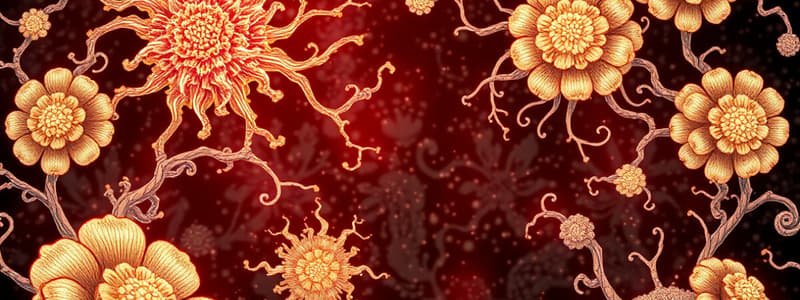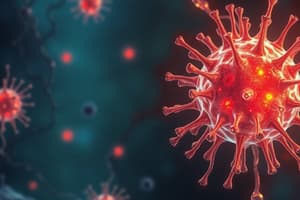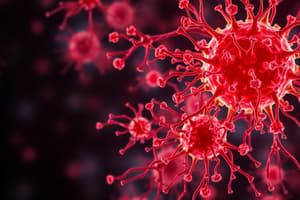Podcast
Questions and Answers
Which of the following bacterial structures is recognized by TLR on macrophages?
Which of the following bacterial structures is recognized by TLR on macrophages?
- Peptidoglycan (correct)
- Mannans (correct)
- Nucleic acid (correct)
- Zymosan (correct)
Toll-like receptors (TLRs) are----
Toll-like receptors (TLRs) are----
- Lipids
- Glycoproteins
- Polysaccharides
- Lipopolysaccharides (correct)
Which of the following enhance phagocytosis?
Which of the following enhance phagocytosis?
- Lysozymes
- PAMPs
- Defensins
- Opsonins (correct)
Which of the following cells phagocytose pathogens?
Which of the following cells phagocytose pathogens?
Which of the following are viral PAMPs?
Which of the following are viral PAMPs?
Which of the following is related to innate immunity?
Which of the following is related to innate immunity?
Which of the following is considered a non-specific defense to a pathogen?
Which of the following is considered a non-specific defense to a pathogen?
Which of the following best describes defensins?
Which of the following best describes defensins?
Which of the following best describes lactoferrin?
Which of the following best describes lactoferrin?
Which of the following cells has role in process of antibody dependent cell mediated cytotoxicity (ADCC)?
Which of the following cells has role in process of antibody dependent cell mediated cytotoxicity (ADCC)?
Flashcards
What bacterial structures are recognized by TLRs on macrophages?
What bacterial structures are recognized by TLRs on macrophages?
Peptidoglycan, mannans, zymosan, and nucleic acid are all bacterial structures recognized by TLRs on macrophages. TLRs are pattern recognition receptors that recognize PAMPs (pathogen-associated molecular patterns) on pathogens.
What are Toll-like receptors (TLRs)?
What are Toll-like receptors (TLRs)?
Toll-like receptors (TLRs) are transmembrane glycoproteins that recognize pathogen-associated molecular patterns (PAMPs). They play a critical role in innate immunity by triggering signaling pathways that activate immune responses.
What enhances phagocytosis?
What enhances phagocytosis?
Opsonins are molecules that enhance phagocytosis by coating pathogens and making them more attractive to phagocytic cells like macrophages. Examples include antibodies and complement proteins.
Which cells phagocytose pathogens?
Which cells phagocytose pathogens?
Signup and view all the flashcards
What are viral PAMPs?
What are viral PAMPs?
Signup and view all the flashcards
What is related to innate immunity?
What is related to innate immunity?
Signup and view all the flashcards
What is a non-specific defense against pathogens?
What is a non-specific defense against pathogens?
Signup and view all the flashcards
What are defensins?
What are defensins?
Signup and view all the flashcards
What is lactoferrin?
What is lactoferrin?
Signup and view all the flashcards
Which cells are involved in antibody dependent cell mediated cytotoxicity (ADCC)?
Which cells are involved in antibody dependent cell mediated cytotoxicity (ADCC)?
Signup and view all the flashcards
Study Notes
Innate Immunity
-
Bacterial Structure Recognition by Macrophages: Peptidoglycan, a bacterial component, is recognized by TLRs (Toll-like receptors) on macrophages.
-
Toll-like Receptors (TLRs): TLRs are glycoproteins crucial to the innate immune system.
-
Phagocytosis Enhancement: PAMPs (Pathogen-Associated Molecular Patterns) and opsonins enhance phagocytosis by immune cells.
-
Phagocytic Cells: Macrophages are involved in phagocytosing pathogens. Natural killer cells are also part of the innate immune response, but not directly phagocytic.
-
Viral PAMPs: Viral particles are recognized through their nucleic acids (like DNA or RNA) which are considered viral PAMPs.
Innate Immunity (Continued)
-
Innate Immunity Components: Complement activation (alternative pathway), is a key component related to innate immunity.
-
Non-Specific Defense Against Pathogens: Innate immunity also includes mechanisms like the action of proteolytic enzymes in the small intestine.
-
Defensins: Defensins are proteins that create pores in bacterial membranes, contributing to pathogen destruction.
-
Lactoferrin: Lactoferrin is a protein that inhibits bacterial growth by depriving them of iron.
-
Antibody Dependent Cell Mediated Cytotoxicity (ADCC): Natural killer cells (NK cells) play a role in ADCC, a crucial part of the immune response where antibody-coated pathogens are destroyed by immune cells.
Studying That Suits You
Use AI to generate personalized quizzes and flashcards to suit your learning preferences.




